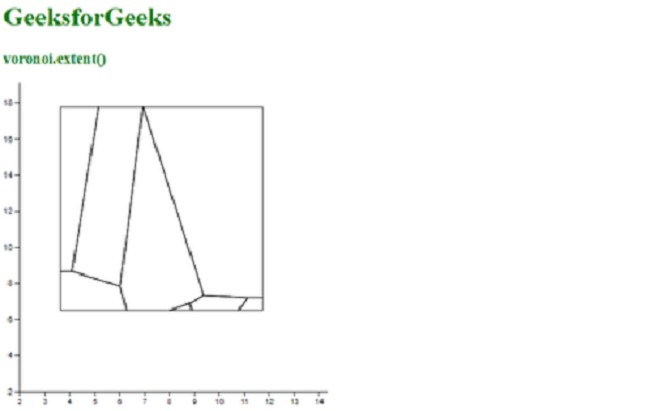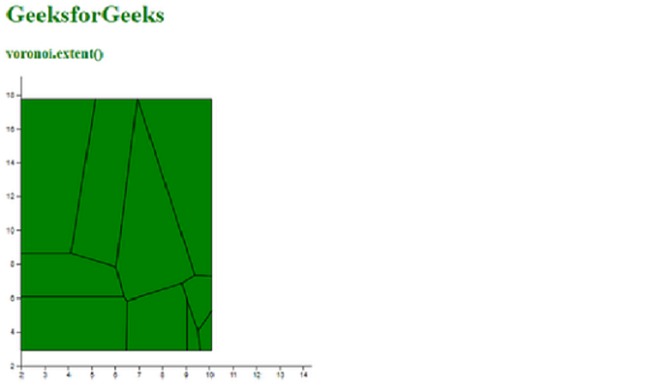voronoi.extent()函数用于设置Voronoi生成器函数的范围。给定的范围值用于在给定的边界内设置Voronoi布局的裁剪范围。边界以二维数组形式给出,看起来像[[x0,y0],[x1,y1]]。如果未指定范围,则它将返回其默认值为null的当前剪辑范围。
用法:
d3.voronoi().extent([extent]);
参数:此函数采用上面给出的和下面描述的一个参数。
- extent:它告知要修剪的区域。它采用二维数组形式的值。
返回值:此函数不返回任何内容。
注意:请创建一个“data.csv”文件。该文件的数据在下面的代码中给出。
下面给出了Voronoi.extent()函数的一些示例。
范例1:
HTML
<!DOCTYPE html>
<html lang="en">
<head>
<meta charset="UTF-8">
<meta name="viewport" content="
width=device-width, initial-scale=1.0">
<script type="text/javascript"
src="https://d3js.org/d3.v4.min.js">
</script>
<script src="https://d3js.org/d3-voronoi.v1.min.js">
</script>
</head>
<body>
<h1 style="color:green">GeeksforGeeks</h1>
<h3 style="color:green">voronoi.extent()</h3>
<script>
d3.csv("data.csv", function(error, data){
var svg = d3.select("body")
.append("svg")
.attr("height", 400)
.attr("width", 400)
.append("g")
.attr("transform",
"translate(" + 20 + ", " + -20 + ")");
var y = d3.scaleLinear()
.domain([2, 20])
.range([400, 0]);
var x = d3.scaleLinear()
.domain([2, 15])
.range([0, 400]);
svg.append("g")
.call(d3.axisLeft(y));
svg.append("g")
.attr("transform",
"translate(0, " + 400 + ")")
.call(d3.axisBottom(x));
var voronoi = d3.voronoi()
.x(function(d) { return x(d.x); });
voronoi.y(function(d) { return y(d.y); })
// Setting the extent using voronoi.extent()
.extent([[50, 50], [300, 300]]);
svg.append("g").selectAll("path")
.data(voronoi(data).polygons())
.enter()
.append("path")
.attr("d", (d)=>{ return d ?
("M" + d.join("L") + "Z"):null; })
.attr("fill", "none")
.attr("stroke", "black");
});
// Data for CSV file
// x, y, group
// 45, 4.4, H
// 9.1, 4.4, H
// 9.9, 9.9, H
// 4.45, 9.6, H
// 4, 7.6, H
// 9, 45, H
// 4, 9.7, H
// 9.7, 4.7, H
// 9.9, 4.5, H
// 4, 4.5, H
// 7.9, 9, H
// 9.9, 45, H
// 9, 4.4, H
</script>
</body>
</html> 输出:

范例2:
HTML
<!DOCTYPE html>
<html lang="en">
<head>
<meta charset="UTF-8">
<meta name="viewport" content="
width=device-width, initial-scale=1.0">
<script type="text/javascript"
src="https://d3js.org/d3.v4.min.js">
</script>
<script src="https://d3js.org/d3-voronoi.v1.min.js">
</script>
</head>
<body>
<h1 style="color:green">GeeksforGeeks</h1>
<h3 style="color:green">voronoi.extent()</h3>
<script>
d3.csv("data.csv", function(error, data){
var svg = d3.select("body")
.append("svg")
.attr("height", 400)
.attr("width", 400)
.append("g")
.attr("transform", "translate
(" + 20 + ", " + -20 + ")");
var y = d3.scaleLinear()
.domain([2, 20])
.range([400, 0]);
var x = d3.scaleLinear()
.domain([2, 15])
.range([0, 400]);
svg.append("g")
.call(d3.axisLeft(y));
svg.append("g")
.attr("transform", "translate(0, " + 400 + ")")
.call(d3.axisBottom(x));
var voronoi = d3.voronoi()
.x(function(d) { return x(d.x); });
voronoi.y(function(d) { return y(d.y); })
// Setting the extent using voronoi.extent() function
.extent([[0, 50], [250, 380]]);
svg.append("g").selectAll("path")
.data(voronoi(data).polygons())
.enter()
.append("path")
.attr("d", (d)=>{ return d ? ("M" + d.join("L") + "Z"):null; })
.attr("fill", "green")
.attr("stroke", "black");
});
// Data for CSV file
// x, y, group
// 45, 4.4, H
// 9.1, 4.4, H
// 9.9, 9.9, H
// 4.45, 9.6, H
// 4, 7.6, H
// 9, 45, H
// 4, 9.7, H
// 9.7, 4.7, H
// 9.9, 4.5, H
// 4, 4.5, H
// 7.9, 9, H
// 9.9, 45, H
// 9, 4.4, H
</script>
</body>
</html> 输出:

相关用法
- PHP imagecreatetruecolor()用法及代码示例
- p5.js year()用法及代码示例
- d3.js d3.utcTuesdays()用法及代码示例
- PHP ImagickDraw getTextAlignment()用法及代码示例
- PHP Ds\Sequence last()用法及代码示例
- PHP array_udiff_uassoc()用法及代码示例
- PHP geoip_continent_code_by_name()用法及代码示例
- d3.js d3.map.set()用法及代码示例
- PHP GmagickPixel setcolor()用法及代码示例
- PHP opendir()用法及代码示例
- PHP cal_to_jd()用法及代码示例
- d3.js d3.bisectLeft()用法及代码示例
- PHP stream_get_transports()用法及代码示例
- PHP Ds\Deque pop()用法及代码示例
注:本文由纯净天空筛选整理自tarun007大神的英文原创作品 D3.js voronoi.extent() Function。非经特殊声明,原始代码版权归原作者所有,本译文未经允许或授权,请勿转载或复制。
